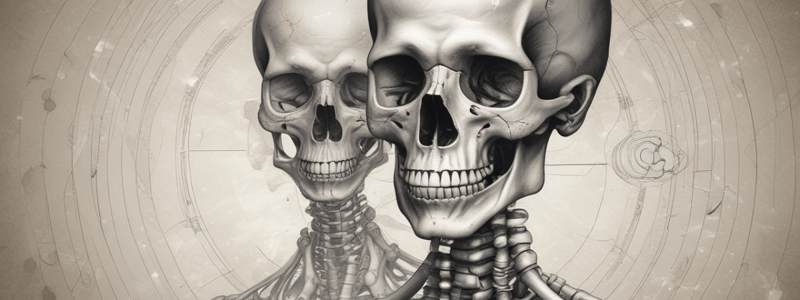Podcast
Questions and Answers
What is achondroplasia caused by?
What is achondroplasia caused by?
- Gain-of-function mutations in fibroblast growth factor receptor 3 (FGFR3) (correct)
- Interference with acidification of osteoclast resorption pit
- Deficiencies in the synthesis of type I collagen
- Abnormalities in the migration of mesenchyme
Which disorder is known as marble bone disease?
Which disorder is known as marble bone disease?
- Achondroplasia
- Osteogenesis Imperfecta
- Dysostosis
- Osteopetrosis (correct)
What primarily causes osteogenesis imperfecta?
What primarily causes osteogenesis imperfecta?
- Abnormal neural foramina
- Gain-of-function mutations in FGFR3
- Deficiencies in type I collagen synthesis (correct)
- Too much bone formation
Which is a clinical feature of severe infantile osteopetrosis?
Which is a clinical feature of severe infantile osteopetrosis?
What is a major cause of dwarfism?
What is a major cause of dwarfism?
What causes blue sclerae in osteogenesis imperfecta?
What causes blue sclerae in osteogenesis imperfecta?
Which of these is affected primarily by osteopetrosis?
Which of these is affected primarily by osteopetrosis?
What is a characteristic feature of those affected by achondroplasia?
What is a characteristic feature of those affected by achondroplasia?
Study Notes
Congenital Anomalies
- Congenital anomalies result from localized abnormalities in mesenchyme migration and condensation (dysostosis) or global disorganization of bone and/or cartilage (dysplasia).
Achondroplasia
- Achondroplasia is an autosomal dominant disorder caused by retarded cartilage growth due to gain-of-function mutations in fibroblast growth factor receptor 3 (FGFR3).
- It is the most common skeletal dysplasia and a major cause of dwarfism.
- Affected individuals have shortened proximal extremities, a trunk of relatively normal length, and an enlarged head with specific facial features.
Type I Collagen Diseases (Osteogenesis Imperfecta)
- Osteogenesis Imperfecta is the most common inherited disorder of connective tissue caused by deficiencies in the synthesis of type I collagen.
- It principally affects bone and other tissues rich in type I collagen.
- The inheritance pattern is autosomal dominant.
- The fundamental abnormality is too little bone, leading to extreme skeletal fragility.
Osteogenesis Imperfecta - Other Findings
- Blue sclerae are due to decreased collagen content.
- Hearing loss is related to sensorineural deficit and impeded conduction.
- Dental imperfections include small, misshapen, and blue-yellow teeth due to dentin deficiency.
Osteopetrosis
- Osteopetrosis is also known as marble bone disease, characterized by reduced bone resorption and skeletal sclerosis.
- Bones are abnormally brittle and fracture easily.
- The condition is classified into variants based on inheritance and clinical severity.
Osteopetrosis - Genetic Mutations
- Genetic mutations interfere with acidification of osteoclast resorption pit.
- Bones lack medullary canal, with bulbous and misshapen long bone ends.
Osteopetrosis - Clinical Features
- Small neural foramina compress exiting nerves.
- Primary spongiosa persists, filling medullary cavity.
- Severe infantile osteopetrosis is often fatal due to leukopenia despite extramedullary hematopoiesis.
Osteopetrosis - Mild Form
- Mild autosomal dominant form may not be detected until adolescence or adulthood.
- It is often discovered on radiographic studies for repeated fractures.
- Individuals may have mild cranial nerve deficits and anemia.
Studying That Suits You
Use AI to generate personalized quizzes and flashcards to suit your learning preferences.
Description
This quiz covers congenital anomalies, including achondroplasia, a genetic disorder that affects bone growth and is a common cause of dwarfism.




